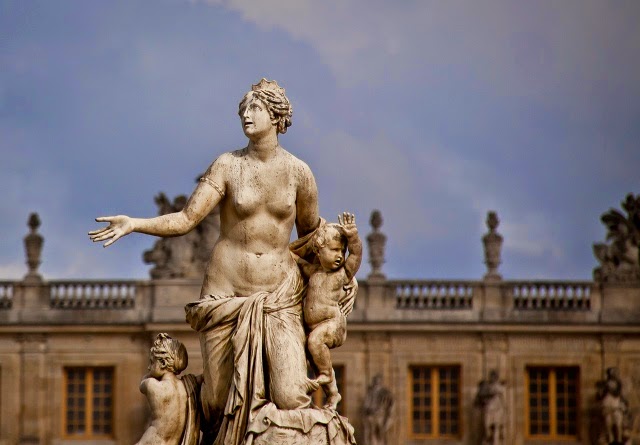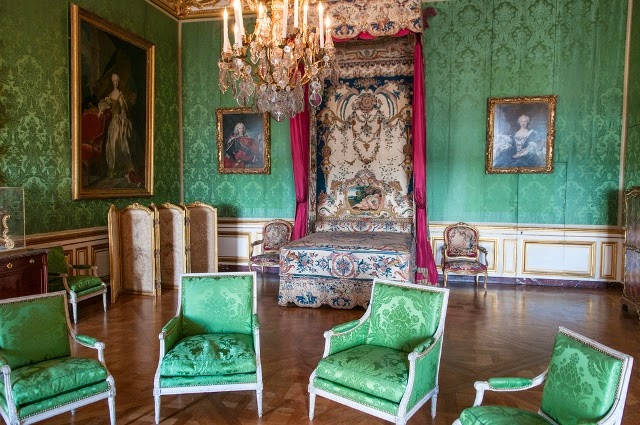Versailles is a city in Île-de-France region, located in the western suburbs of the French capital, 17.1 km (10.6 mi) from the center of Paris. It is world-widely renowned for its royal château (palace), the Château de Versailles and the gardens of Versailles, designated UNESCO World Heritage Sites. When the château was built, Versailles was a mere country village. Today, it is a small city and one of France’s most popular tourist destinations. The magnificent Palace of Versailles, is truly an architectural masterpiece. It is arguably one of the very finest royal palaces ever to be built.
The court of Versailles was the center of political power in France from 1682, when Louis XIV moved from Paris, until the royal family was forced to return to the capital in October 1789 after the beginning of the French Revolution. Versailles is therefore famous not only as a building, but as a symbol of the system of absolute monarchy of the Ancien Régime. Versailles is also known for numerous treaties such as the Treaty of Paris (1783), which ended the American Revolutionary War and the Treaty of Versailles, after World War I.
History of the Château
The site began as Louis XIII’s hunting lodge before his son Louis XIV transformed and expanded it. Following the Treaties of Nijmegen in 1678, he began to gradually move the court to Versailles. The court was officially established there on 6 May 1682. Each of the three French kings who lived there until the French Revolution added improvements to make it more beautiful. The construction and expansion of Château de Versailles was done through four distinct building campaigns over a 50 year period.
The first campaign started in mid 17th century and was initiated because Louis was about to host a major party for the two queens of France. During this phase, the palace witnessed alterations in the both the building and gardens in order to accommodate the 600 guests invited to a party. The second building campaign started a few years later. This phase included the construction of several apartments and lodging facilities, including the classic “Grand Apartment Du Roi”. The third campaign began some 10 years later. During this phase, the Château de Versailles acquired much of the look that it has today, including the brilliant Hall of Mirrors. It was at this time, in 1682, that Louis XIV officially installed his court at Versailles. Louis XIV undertook his last building campaign at Versailles at the start of the 18th century. The fourth building campaign concentrated on construction of the royal chapel as well as some modifications in the Apartment Du Roi.
At the end of the 18th century after the French Revolution, Château de Versailles lost its function as a royal palace. The temporary government in charge, the National Convention, arranged for the majority of the palace furniture to be either sold or rented. During the time after the revolution - with Napoleon Bonaparte, the Bourbon Restoration and the Second Empire - the palace received little attention. It was primarily used for different state events and during visits by political and royal foreigners.
It was not until after the Second World War that the palace once again gained some attention, this time in the form of renovations. A major project was initiated in the mid 20th century in an attempt to bring back to its former glory and to once again put it on the world map. A new roof to the Hall of Mirrors was added and several chambers and apartments were restored. Additionally, a policy was established in which the French government would aggressively seek to acquire as much of original furniture and artwork as possible, as much had been dispersed at the time of the Revolution.
Gardens of the Palace
From the central window of the Hall of mirrors the visitor look down on the grand perspective that leads the gaze from the Water Parterre to the horizon. This original perspective, which preceded the reign of Louis XIV, was developed and prolonged by widening the Royal Path and digging the Grand Canal. This vast perspective stretches from the façade of the Château de Versailles to the railings of the park. In 1661, Louis XIV commissioned André Le Nôtre with the design and laying out of the gardens of Versailles which, in his view, were just as important as the Château. The works were undertaken at the same time as those for the palace and took forty years to complete.
The Hall of Mirrors
The Grande Galerie, as it was called in the 17th century, served daily as a passageway and a waiting and meeting place, frequented by courtiers and the visiting public. After the victory over the three united powers, represented in the Salon de la Guerre (War Room) and the gallery’s 73 meters glorified the political, economic and artistic success of France. Political success is demonstrated by thirty compositions in the arch painted by Le Brun, which illustrate the glorious history of Louis XIV in the first eighteen years of his government, from 1661 until the Peace of Nijmegen. Military and diplomatic victories, as well as reforms in view of the reorganization of the kingdom, are portrayed in the form of antique allegories. Economic prosperity is demonstrated by the dimensions and quantity of the 357 mirrors that decorate the seventeen arches opposite the windows, attesting that the new French production of mirrors, which at the time were luxury objects, is capable of stealing the monopoly away from Venice. It was here that the treaty of Versailles was signed on 28th June 1919, which sealed the end of the First World War. Since then, the presidents of the Republic of France continue to receive the official hosts of France here.
The Battles Gallery
The biggest section in the History Galleries of Versailles is the Battles Gallery. It occupies nearly all the two upper floors of the South Wing of the Palace up to the roof. Designed and laid out beginning in 1833, it was solemnly opened on 10 June 1837 and was regarded as the highlight of the visit to the museum. Louis-Philippe brought together here 33 paintings depicting the main battles that France had fought, from the Battle of Tolbiac in 496 to the Battle of Wagram in 1809. Designed by Frédéric Nepveu, It forms a solemn and majestic arcade, divided at intervals by projecting groups of columns bearing an arch, lit by a glass roof in the vault and richly decorated with marble sculptures and painted and gilt stucco work.
The Grand Trianon
In 1687 Jules Hardouin Mansart built the Grand Trianon, probably the most refined group of buildings anywhere in the domain of Versailles, on the site of the “Porcelain Trianon”, which Louis XIV had erected in 1670 to escape the pomp and rigid formality of court life with his mistress Madame de Montespan. Napoleon Bonaparte had the palace restored before staying here on many occasions with his second wife, Empress Marie-Louise. In 1963 Charles de Gaulle had it restored as a guesthouse for presidents of France and the northern wing, known as “Trianon-sous-bois”, was converted into an official presidential residence.
Marie-Antoinette's estate
Opened in 2006, the Marie-Antoinette's estate reveals her private life. The Petit Trianon and its park are indissolubly linked to the memory of Queen Marie-Antoinette. She is the only queen to have imposed her personal taste on Versailles. Sweeping away the old court and its traditions, she insisted on living as she wished. In her Trianon domain, which Louis XVI gave her in 1774, she found the heaven of privacy that enabled her to escape from the rigors of court etiquette. Nobody could come there without her invitation.
Text Sources :
wikipedia.org
chateauversailles.fr
worldsiteguides.com






























